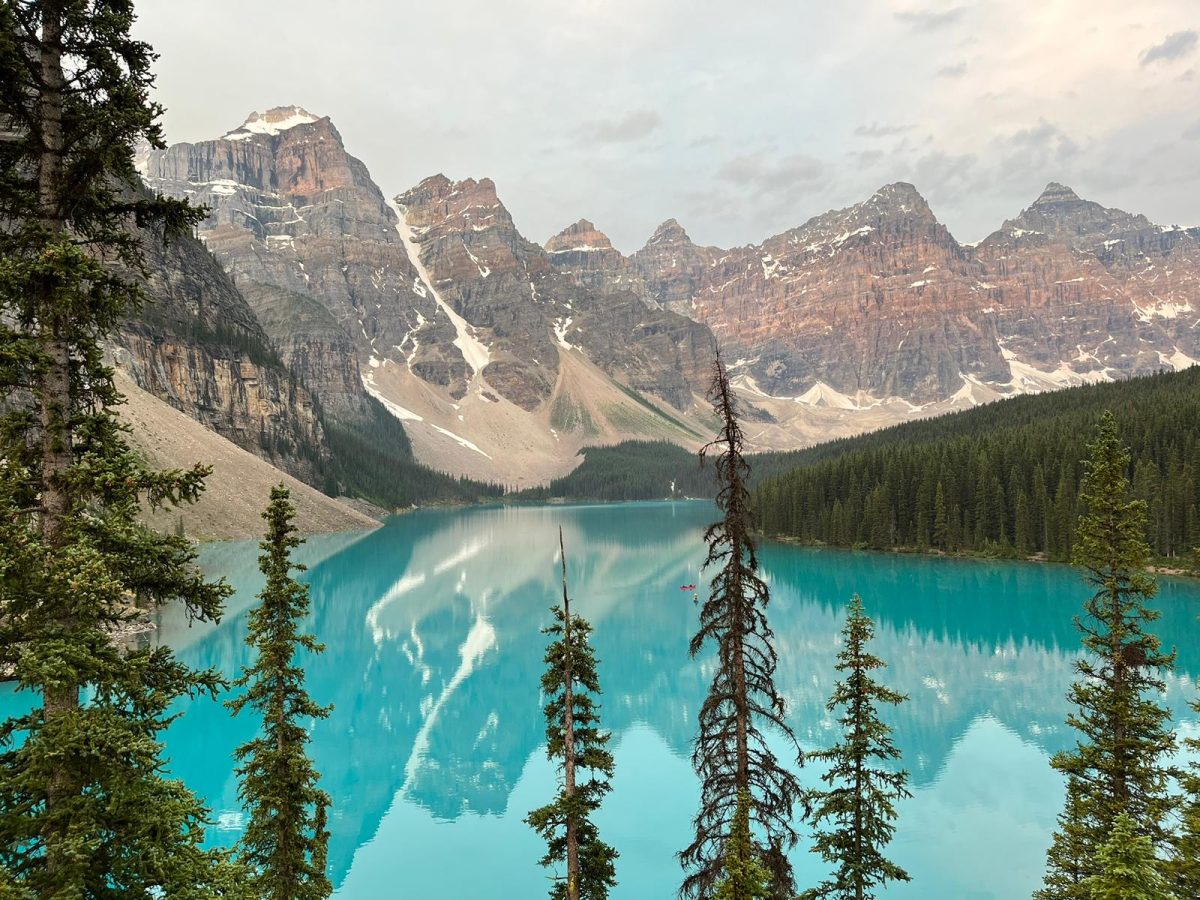Nature is impacted by processes that create changes over millions of years. Over time, these processes form landforms that are the center of tourist attraction and nature preservation through national parks. Jasper hosts a national park with special activities for tourists to see many natural features, such as glaciers with the Columbia Ice Field and bodies of water like Medicine Lake. The processes must be first understood to understand the beauty of the landforms found in British Columbia Alberta.
40,000 years ago at the peak of the Wisconsin glaciation, the Rocky Mountains were covered with moving ice. The valleys were filled with continental ice sheets that covered Canada and most of the northern United States. Wind with moisture collected from the Pacific Ocean flows inland to cross the mountains of Western Canada, each time it lifts it cools and clouds form that rain and snow. Glaciers form where snow doesn’t fall away and there is a ledge or relatively flat surface for snow to accumulate. This place for the Columbia Icefield is a high plateau enclosed by some of the tallest mountains in the Rockies, covering more than 300 square kilometers while cradling the icefield upon it and blocking the moist air systems from the west. As storm clouds rise to cross this barrier, they release more snow than falls anywhere for hundreds of kilometers to the north. When grains are compacted by more layers of snow, meltwater refreezes between the crystals, the air is slowly squeezed out of the snow, and ice is formed. To create glaciers, at least 30 meters of snow must accumulate and age to become grains, crystals, and then ice, and the ice should have somewhere to flow.
Summer meltwater streams carve channels with some streams flowing on the surface for a large distance and forming millwells (rounded drains where meltwater streams plunge into the ice) before merging with larger streams and forming glacial river gates (meltwaters emerge as large streams from tunnels at the toe of the glacier).
The Canadian Rockies are formed by sedimentary rock including shale, sandstone, dolomite, and limestone. Most geologic formations in Banff range from the Precambrian to the Jurassic periods (600–145 million years ago). However, rocks as young as the lower Cretaceous can be found near the east entrance and on Cascade Mountain above the Banff townsite. These sedimentary rocks were laid down in shallow seas between 600 and 175 million years ago and were pushed east during the Laramide orogeny. The mountain building in Banff National Park ended approximately 55 million years ago. After mountain formation ceased, erosion carved the mountains into their rugged shape. The erosion was first due to water, then was greatly accelerated by the Quaternary glaciation 2.5 million years ago.
Many mountain ranges trend northwest to southeast, with sedimentary layering dipping to the west at 40–60 degrees. This leads to dip slope landforms, with generally steeper east and north faces, and trellis drainage, where rivers and old glacial valleys followed the weaker layers in the rocks as they were relatively easily weathered and eroded. Erosion and deposition of higher-elevation rock layers have resulted in scree deposits at the lowest elevations of many of the mountains.
Glacial erosion has formed many landforms by sweeping away rock and silt fragments eroded in the ice. Glacial cliffs are formed when glaciers loosen stone to undercut rock walls and become cliffs. Mountains have been influenced by glacial erosion into irregular, anticlinal, synclinal, castellate, dogtooth, and sawback mountains in Banff National Park. Glacial forms like cirques, arêtes, hanging valleys, moraines, and U-shaped valleys are also present.
Banff has many glaciers and icefields that can be seen from the Icefield Walkway. Small cirque glaciers are common in the Main Ranges, situated in depressions on the side of many mountains. As with the majority of mountain glaciers around the world, the glaciers in Banff are retreating. The largest glaciated areas include the Waputik and Wapta Icefields, which lie on the Banff-Yoho National Park border. Wapta Icefield covers approximately 31 square miles in area. Outlets of Wapta Icefield on the Banff side of the continental divide include Peyto, Bow, and Vulture Glaciers. Bow Glacier retreated an estimated 1,100 meters between 1850 and 1953 and has left a newly formed lake at the terminal moraine. Peyto Glacier has lost 70 %of its volume since record-keeping began and has retreated approximately 2,000 meters (6,600 ft) since 1880; the glacier is at risk of disappearing entirely within the next 30 to 40 years.
At the northern end of Banff, the Columbia Icefield straddles the Banff and Jasper National Park border and extends into British Columbia. Snow Dome, in the Columbia Icefield, is a hydrological apex of North America, with water flowing via outlet glaciers to the Atlantic, Pacific, and Arctic Oceans. Saskatchewan Glacier, which is approximately 13 kilometers (8 miles) in length and 30 square kilometers (12 square miles) in area, is the major outlet of the Columbia Icefield that flows into Banff National Park. Between 1893 and 1953, Saskatchewan Glacier retreated a distance of 1,364 meters (4,475 feet), with the rate of retreat between the years 1948 and 1953 averaging 55 meters (180 feet) per year.
With the climate warming up, Athabasca Glacier has been retreating and creating moraines and trim lines in the Sunwapta River Valley. Both within their ice and on top of it, glaciers carry debris that will become glacial till. As the ice flows and melts, the glaciers deposit their debris in distinctive shapes. As ice melts at the glacier’s toe, the rock debris in and on the ice is deposited as piles of till in front of the glacier called end moraines. When the glacier stops advancing and its toe remains almost stationary for some years before beginning to retreat, the till accumulates into a large, distinctive mound known as a terminal moraine. Rock and debris falling from surrounding cliffs form large piles on the glacier’s edge. As the glacier shrinks, the debris is left as a knife-edged ridge of debris with a core of blue glacier ice that melts more slowly. As a glacier retreats, large areas of ice may become isolated from the glacier and gradually melt in one place. When the ice has melted, it creates a dead ice moraine with a landscape full of small hills and depressions, filled with varying amounts of glacial till. A timeline or a distinct boundary between the old forest and the area where the glacier left raw gravel and silt is formed where a glacier has advanced down forested valleys and retreated again, creating a trim line.
With such natural landmarks, the realization that they have to be conserved was created through efforts to industrialize. It began when officials permitted hydroelectric developments to construct a dam at the outlet of Lake Minnewanka in 1912. A member of the Parks Department commented on the hydroelectric developments in the national park. “The reason is that the mountain lakes in the Rockies which are famous for their beauty, such as Lake Louise, are glacial cirques, while Minnewanka is only a flooded river valley,” a Parks Department member said. “By clearing these flats and raising the water levels as proposed, they will be submerged, and the general appearance of the lake very materially improved” (UCL Press).
However, hydro-industrial development’s incompatibility with the image of the park and its experience with the park boundary shifting to protect wilderness rather than a site. This led to the parks branch establishing a doctrine of inviolability for national parks, conceding territory to maintain the premise of pure, untouched wilderness within its borders.
Historians Christopher Armstrong and H. V. Nelles explained the perspective behind the stronger commitment to the National Parks Act. “The argument that hydroelectric development should not take place within national parks, a point of view that seemed to gain wide public acceptance, when forced through the sausage machine of federal politics in the late 1920s, led to the remarkable conclusion that such places should not be within national parks in the first place,” they said. “After lengthy negotiations between the Province of Alberta and the federal government, it was finally agreed that these lands should be removed from what had become Banff National Park because of their potential commercial value as a hydroelectric storage reservoir” (UCL Press).
The parks branch and J.B. Harkin tied tourism towards profit for national parks. The continued need for an economic argument to justify setting aside national parks meant a constant affiliation of these spaces with tourism industries and infrastructure. Celebrating wilderness while simultaneously consuming it in Canada has required heavy calculation, weighing cultural and aesthetic desires against economic metrics to inform development. Banff National Park remains a celebrated icon of Canadian wilderness, with sites like Lake Louise. The notion that the space within Banff National Park is perfectly conserved or untouched can undermine the fact that the park itself is a human construct. The history of Banff National Park and its boundaries tells a story of attempts to curate and market an experience of wilderness, representing how valuable conservation is while supporting tourism.
Banff National Park continues its growth in maintaining a healthy park with prescribed fires. It helps many species survive and thrive, creating new, healthier ecosystems. Fire kick-starts regeneration by providing ideal growing conditions for sun-loving plant species. Greater airflow helps dry the soil, reducing fungal diseases like Blister Rust. Fire helps thin the forest and open the canopy, allowing more sunlight to reach the forest floor. Wildlife searches out recently burned areas, searching for the nutritious plants and grasses that are the first to pop up. Over time, fires create a rich variety of habitats with diverse plants that support many species of insects, mammals, and birds to support biodiversity. Fire also releases and recycles nutrients into the soil by reducing woody debris and other organic matter into mineral-rich ash.
Despite this, measures must be taken to conserve nature in Canadian natural parks. When it becomes hot, major parts of Banff and Jasper National Parks are at risk of being caught in wildfires. To reduce the risk of wildfire to communities, Parks Canada removes the buildup of flammable vegetation near where humans meet nature. National Parks of Canada Fire Protection Regulations are the legal foundation for Parks Canada’s fire prevention protocols that allow park managers to close or restrict access to any park area. The regulations may also prohibit smoking in specific areas and prohibit visitors from starting or maintaining fires. In national parks, fires are only permitted inside metal fire rings or boxes provided by Parks Canada. Under these regulations, random, open fires are prohibited. There is always some level of fire restriction or ban in place inside national parks. Parks Canada’s regulations also require anyone who has started a fire to fully extinguish it before leaving.
While we cannot avoid naturally occurring wildfires (ex: lightning strikes), we can for human-caused fires. To do our part to help conserve the national parks and keep our communities and first responders safe, we can not light illegal campfires and safely dispose of cigarettes and hot ashes from BBQs. Never leave your fire unattended and ensure your campfire is cold before leaving.
In conclusion, the natural beauty of the Canadian Rockies and the surrounding national parks is due to millions of years of geological processes and glacial activity. The formation of landforms such as glaciers, icefields, and mountain ranges has created a unique and diverse landscape that attracts tourists and serves as a vital ecosystem for nature preservation. However, the impact of climate change on the region’s glaciers, as evidenced by their retreat and loss of volume, highlights the need for continued environmental conservation efforts to protect this natural heritage for future generations.









